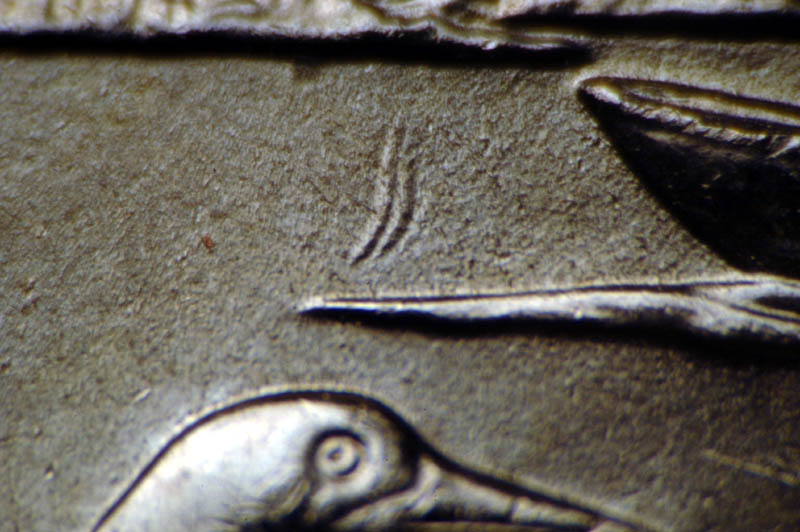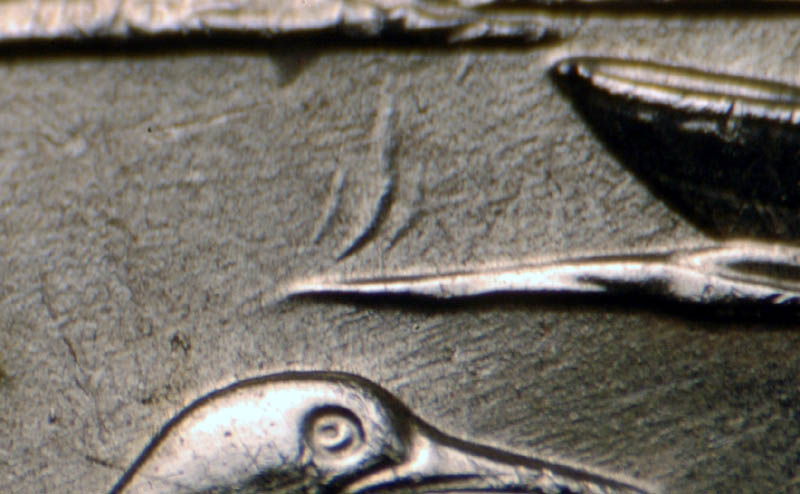
Here the coin was shot angle to best highlight the fish-like
clash mark in front of the boat.
This was the so-called leaping fish that some eBay sellers were offering on eBay!
Of course it just isn't so! I found about a roll of these while looking
for doubled dies.
Back in 2006, the 2005-P-D-S Minnesota State quarters with various doubled dies restricted to central areas of the reverse design were red hot! Most of them involved the third full tree to the right of the Minnesota State outline with a portion of that tree hub doubled with the secondary image showing as a shift out in the field as a totally separated partial tree. Thus, they were nicknamed the "extra tree" varieties. At any one time dozens of them could be found being offered on eBay and week after week John Wexler and I wrote stories on the new finds as they came in, for Numismatic News and Coin World. They were so hot with so many collectors looking for them that they started finding other aberrations on the coins that they felt were doubled dies or "design add-ons" related to the Mint deciding to include "extra" elements into the design. One common type of variation that fooled a lot of folks was the die clash.

Here we can see a clash mark caused by the upper jaw-line of
Washington. It runs from the rock and behind and above the tree.
Some folks on eBay promoted this as smoke from a campfire -- something that it
definitely is not!
The one shown here is one of a number of 2005-P Minnesota quarters that exhibit die clash marks on the obverse and reverse. On this one you can see the effects of a high point on the die from the lines in Washington's hair (wig) clashed on the reverse in front of the boat. It looks kind of like a fish leaping out of the water and in fact many folks made the claim that this was in fact what it was in spite of the fact their contentions had no basis in fact. In fact they still get offered as such from time to time!
Other evidence of the clash on the reverse of this variety shows as an area of deformation in the field between the third and fourth full trees (right of the state outline) and seemingly running behind and above the third tree. Some claim that these are abrasion marks and are evidence of where an "extra tree" doubled die once appeared and was later removed by the Mint. Others with more vivid imaginations, claim this is smoke coming up from a campfire in the forest! This obviously is NOT the case but it helps sell coins for those who just don't care if their descriptions are set within the framework of reality or fantasy!
On the obverse we see some of the outlines of trees from the reverse clashed into Washington's portrait below his ear and on either side. In a sense these are "extra trees" in that they are outlines of trees due to the clash but certainly not a result of hub doubling (doubled dies).
The die clash occurs when the planchet delivery system fails to deposit a planchet between the dies and the press cycles and the dies smash or clash into each other. When this occurs the design of one or both dies may impart outlines on each other. Coins struck with these dies will, of course, show these aberrations until they are removed by the Mint or wear away.
The effects of die clashes can certainly be interesting and in some cases, are considered very collectable, but they should always be described as what they are, even in promotions where commonly accepted nicknames are also being used.

Here we see another clash mark extending from the fifth full tree right of
the state outline.

Clash marks from the highest relief areas of the die between
the trees on the reverse take on an inverted tree-like
appearance on the obverse
where they seem to be hanging upside-down from Washington's earlobe and areas on
either side.

Here's a composite of the Minnesota quarter obverse and reverse design. The Washington design was
rotated 180 degrees and horizontally flipped in Photoshop. This configuration
shows how the obverse and reverse designs relate to each other during a
clash. When the geometry of a design allows, clash marks are most apt to
show up in the center of the coin first since coinage dies are convex with their
highest areas in the center were the design allows. With this composite
design you can see exactly where the various clash marks on this design
originate from. (You can also see where stronger clashes might occur when
they extend out further from the centralized areas -- as they may on stronger
clashed die varieties).

Here's another clashed die variety sent in by Scott Casey
that shows two distinct fish-like areas of clash from the obverse wig and traces
of a third.

Here is yet another die clash variety sent in by Rhonda Snyder or
MD with wider spaced traces of fish-like marks in front of the boat.
Ken Potter
P.O. Box 33
Pinckney, MI 48169
Phone: 1-(313)255-8907 E-mail: KPotter256@aol.com
Numismatist Since 1959 ~ Serving
the Collector Since 1973
CONECA's Longest Serving Doubled Die Attributer
Member of: ANA-LM CONECA-LM NLG NCADD-FM
MSNS-LM
NWDCC RCC WBCC BBCC IASAC
Ken Potter's
Variety Vault
Educational Image
Gallery
Who Is Ken Potter?
Unless otherwise stated, all Photographic Images are by Ken
Potter. Copyright Ken Potter, 1993-2008. Use of images in any manner is strictly prohibited without the express written
permission of the copyright holder.